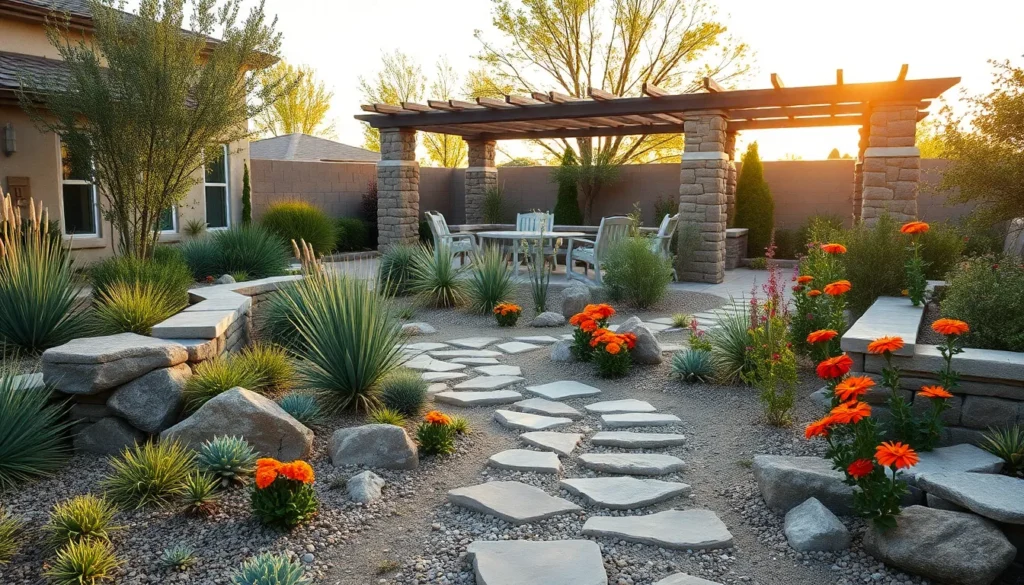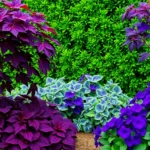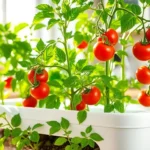Water-wise gardening isn’t just a trend—it’s the smart solution for creating stunning outdoor spaces that thrive in challenging conditions. Whether you’re facing drought restrictions, sandy soil, or simply want to reduce your water bills, dry gardens offer incredible beauty without the constant maintenance demands of traditional landscapes.
We’ve discovered that xerophytic plants and drought-tolerant design techniques can transform even the most barren spaces into breathtaking outdoor sanctuaries. From sculptural succulents to flowing ornamental grasses, these resilient plants create visual interest while requiring minimal irrigation once established.
The best part? Dry gardens aren’t about sacrificing style for sustainability. Modern xeriscaping combines striking textures, bold colors, and architectural elements that rival any high-maintenance garden. You’ll find that these low-water landscapes often become the most captivating features of any property, proving that environmental responsibility and aesthetic appeal go hand in hand.
Choose Drought-Tolerant Plants for Your Dry Garden Foundation
Building on the water-wise gardening principles we’ve explored, selecting the right plants forms the cornerstone of any successful dry garden design. Strategic plant choices ensure your xerophytic industry thrives with minimal irrigation while delivering maximum visual impact.
Select Native Succulents and Cacti
Native succulents and cacti provide the ultimate drought resistance for your dry garden foundation. These water-storing champions naturally adapt to arid conditions and require watering only once every 2-3 weeks during establishment.
Agave varieties like Blue Glow and Century Plant create stunning architectural focal points while storing months of water in their thick leaves. Prickly pear cacti offer vibrant yellow or pink blooms in spring and edible fruits, making them both beautiful and functional additions.
Barrel cacti such as Golden Barrel and Fishhook varieties add perfect spherical shapes to your industry design. Cholla cacti contribute interesting branching structures and attract pollinators with their colorful flowers.
Sedum species work excellently as ground covers, spreading naturally to fill gaps between larger specimens. Hens and Chicks multiply rapidly and create charming rosette patterns that require zero supplemental watering once established.
Incorporate Mediterranean Herbs and Shrubs
Mediterranean plants bring fragrant foliage and culinary value to your drought-tolerant garden while thriving in poor soil conditions. These aromatic specimens typically need watering only during their first growing season.
Lavender varieties like English and Spanish lavender produce fragrant purple spikes that bloom for months while attracting beneficial pollinators. Rosemary bushes grow into substantial shrubs reaching 3-6 feet tall and provide year-round evergreen structure.
Sage plants including culinary and ornamental varieties offer silvery foliage and colorful flower spikes in blues, purples, and reds. Thyme species create excellent ground covers that release pleasant scents when walked upon.
Oregano and marjoram spread naturally to form dense mats while providing fresh herbs for cooking. Cistus shrubs produce papery flowers resembling wild roses and tolerate extreme heat without wilting.
Add Ornamental Grasses for Texture
Ornamental grasses introduce movement and seasonal interest to dry gardens while requiring minimal care once established. These textural elements typically need watering only 2-3 times during their first summer.
Fountain grass creates soft, flowing plumes that sway gracefully in breezes and turn golden bronze in fall. Blue fescue forms compact silvery-blue tufts perfect for edging pathways and rock gardens.
Mexican feather grass produces fine, hair-like textures that catch morning dew and create ethereal effects in sunlight. Buffalo grass serves as an excellent lawn alternative requiring 75% less water than traditional turf.
Pampas grass develops dramatic plumes reaching 8-12 feet tall and provides striking winter interest when plumes persist through cold months. Little bluestem offers attractive blue-green summer color that transforms to vibrant orange and red in autumn.
Create Visual Interest with Rock and Stone Features
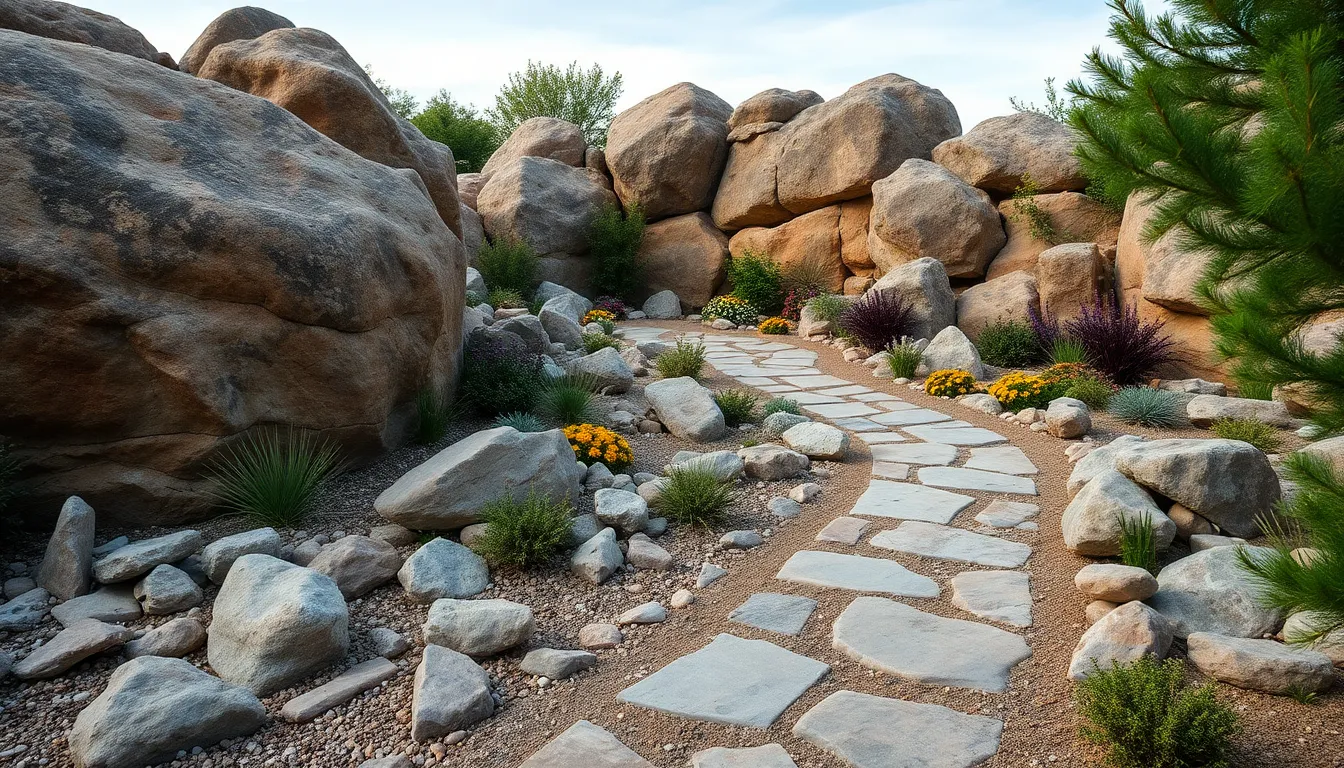
Stone and rock elements transform dry gardens into ever-changing landscapes that catch the eye while requiring minimal maintenance. These hardscape features complement xerophytic plants by providing textural contrast and structural definition to water-wise garden designs.
Install a Rock Garden with Varying Sizes
Rock gardens featuring multiple stone sizes create depth and visual appeal through natural layering techniques. We recommend using large boulders as anchor points, medium-sized rocks for transition areas, and smaller stones or pebbles for ground coverage. This varied approach mimics natural rock formations found in mountainous regions.
Different rock sizes serve practical purposes beyond aesthetics. Large stones retain heat during the day and release it slowly at night, creating beneficial microclimates for nearby plants. Smaller rocks and pebbles provide excellent drainage while suppressing weed growth around drought-tolerant plantings.
Consider incorporating local stone varieties to maintain regional authenticity in your design. Native rocks typically weather better in local climate conditions and blend seamlessly with the surrounding industry.
Build Decorative Stone Pathways
Stone pathways guide visitors through dry gardens while adding sophisticated hardscape elements to the overall design. Flagstones and cobblestones offer durable, low-maintenance options that withstand weather extremes without requiring regular upkeep. These materials develop attractive patina over time, improving their natural beauty.
Natural stone pathways complement drought-resistant plantings by providing clean lines and defined spaces. We suggest spacing stones slightly apart and filling gaps with drought-tolerant ground covers or decorative gravel. This technique softens hard edges while maintaining the pathway’s functional purpose.
Pathway placement should connect key garden features such as seating areas, focal points, or plant groupings. Strategic routing encourages exploration while protecting delicate plants from foot traffic.
Add Boulder Accents as Focal Points
Boulder placement creates dramatic focal points that anchor dry garden compositions and draw attention to exact areas. Large stones serve as natural sculpture elements, providing year-round visual interest regardless of seasonal plant changes. We position boulders strategically to frame views, create natural seating, or serve as backdrops for colorful drought-tolerant specimens.
Single large boulders work effectively as standalone features, while groupings of three or five stones create more complex compositions. Odd-numbered groupings appear more natural and visually balanced than even-numbered arrangements.
Boulder accents also provide practical benefits in xeriscaping designs. They create windbreaks for sensitive plants, offer thermal mass for temperature regulation, and provide habitat for beneficial wildlife such as lizards and beneficial insects that help control garden pests.
Design Water-Wise Landscaping Zones
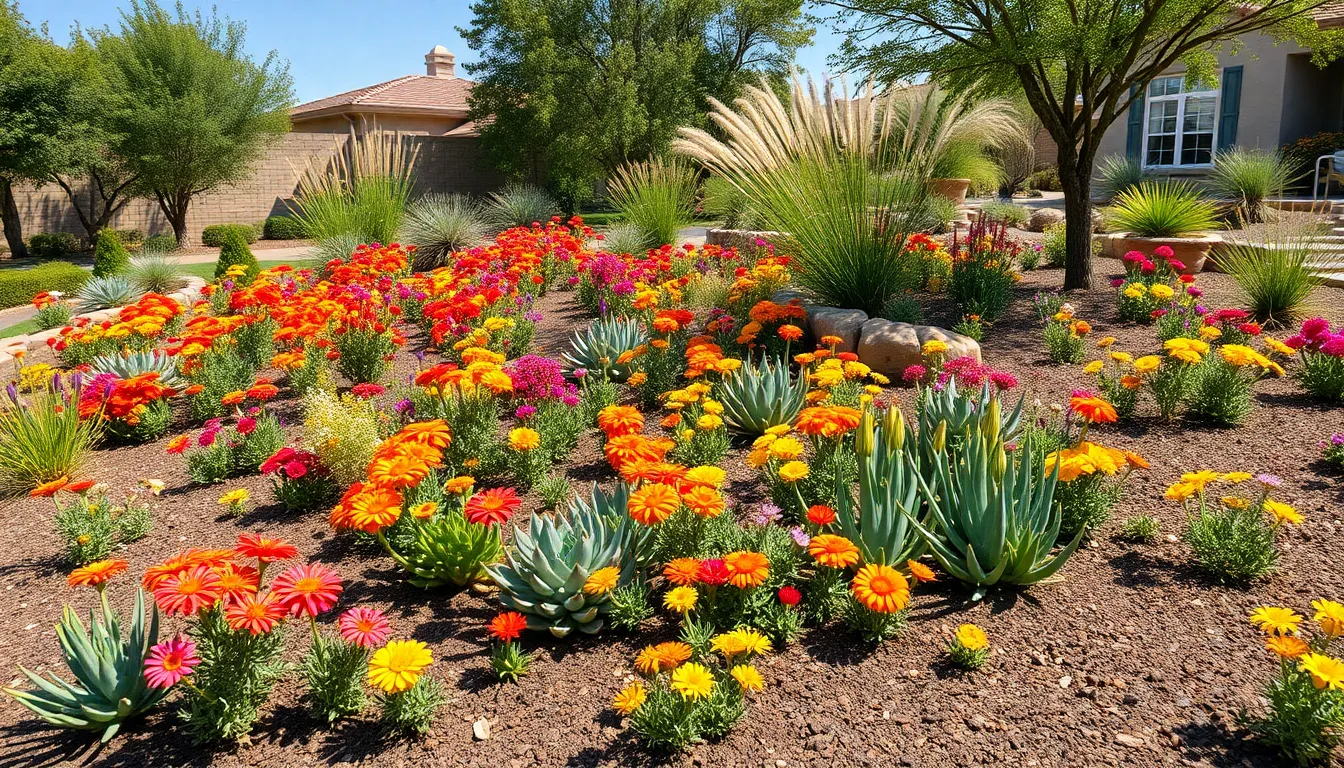
Creating successful water wise landscaping requires organizing your garden into distinct zones that maximize efficiency while maintaining visual appeal. Strategic zoning helps us optimize irrigation while ensuring each plant receives the care it needs to thrive.
Establish Xerophytic Plant Groupings
Group plants by their water requirements to create efficient irrigation zones that reduce waste and promote healthy growth. Drought tolerant flowers like zinnias and marigolds work perfectly together in high visibility areas where you want seasonal color. Succulents and ground covers form dense carpets that suppress weeds while requiring minimal water throughout the growing season.
Position trees and ornamental grasses strategically to create year round structure and visual interest in your dry garden design. Cacti serve as dramatic focal points while providing habitat for beneficial wildlife like birds and pollinators. Native wildflowers can replace traditional lawn areas and offer bursts of seasonal color that change throughout the year.
Combine plants with similar soil preferences to simplify maintenance and ensure optimal growing conditions for each species. Mediterranean herbs thrive in well draining soil alongside other drought adapted plants from similar climates. This approach creates natural looking plant communities that require less intervention over time.
Create Microclimates for Different Plant Needs
Install windbreaks using shrubs or trees to protect sensitive plants from harsh winds that can increase water loss through transpiration. These natural barriers create calm zones where less hardy species can establish and flourish. Strategic placement of these protective elements helps extend your plant palette beyond the most drought resistant varieties.
Apply mulch around plant groupings to retain soil moisture and reduce evaporation rates during hot summer months. Organic mulches break down over time and improve soil structure while providing nutrients to your plants. Stone mulches offer permanent answers that reflect heat and create distinctive textural contrasts.
Design elevation changes to direct water flow and create naturally moist areas for plants that need slightly more water. Gentle slopes and berms help capture and direct rainfall to exact zones where it’s most needed. These topographical features add visual interest while serving important functional purposes.
Plan Strategic Shade Areas
Position larger plants to create natural shade for smaller species that benefit from protection during the hottest parts of the day. This plant placement strategy reduces the need for artificial shading structures while creating layered visual depth. Carefully planned shade patterns help extend the growing season for many flowering species.
Install shading structures like gazebos or pergolas with climbing vines to provide comfortable outdoor living spaces while supporting plant growth. These structures create defined areas for entertaining while serving as vertical growing space for drought tolerant climbers. Pergolas with deciduous vines offer seasonal shade that adapts to changing weather patterns.
Create shade using hardscaping elements like stone walls or fences that provide immediate protection while adding architectural interest to your design. These permanent features offer reliable shade regardless of plant maturity or seasonal changes. Strategic hardscaping reduces maintenance needs while providing year round functionality.
Install Efficient Irrigation Systems
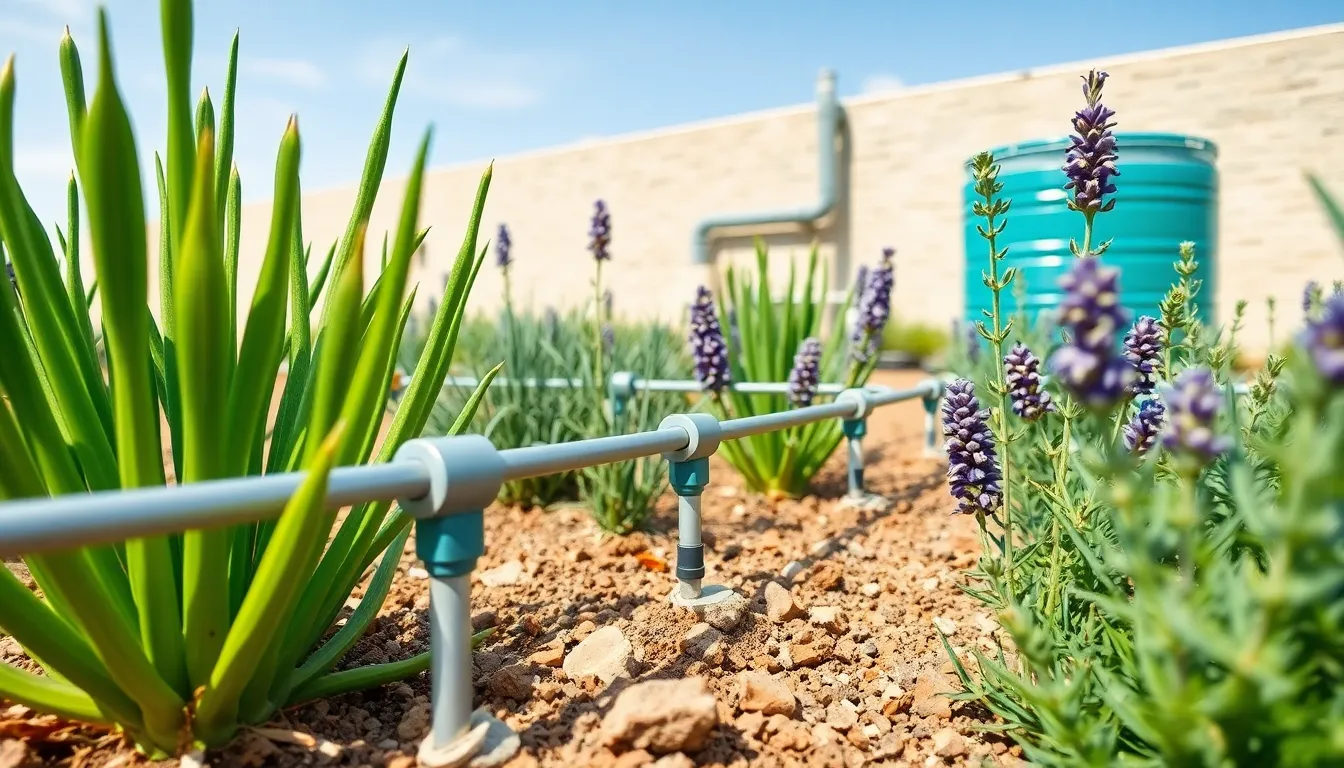
Efficient water delivery becomes crucial for maintaining our drought-resistant industry while minimizing resource consumption. We can carry out several advanced irrigation technologies that transform how our dry gardens receive moisture.
Set Up Drip Irrigation Networks
Drip irrigation networks deliver water directly to plant roots through a series of tubes and emitters placed strategically throughout our garden beds. We install these systems by running main supply lines from our water source to different zones, then connecting smaller distribution tubing to reach individual plants. These networks reduce water usage by up to 60% compared to traditional sprinklers by eliminating evaporation and runoff waste.
We position emitters near the root zone of each plant, allowing water to seep slowly into the soil where it’s needed most. The system works particularly well for our drought-tolerant plants like cacti, sage, and lavender because it provides consistent moisture without oversaturating the soil. We can adjust flow rates for different plant types by selecting appropriate emitter sizes and spacing them according to each plant’s water requirements.
Use Smart Timers and Moisture Sensors
Smart timers automate our irrigation schedules based on real-time weather data and seasonal changes, ensuring we water only when necessary. We program these devices to adjust watering frequency and duration according to temperature, humidity, and rainfall forecasts. This technology prevents us from watering during rainy periods and increases irrigation during hot, dry spells.
Moisture sensors monitor soil conditions at various depths throughout our garden, sending data to our irrigation controller about actual water needs. We install these sensors in different hydrozones to track moisture levels for plants with varying water requirements. The sensors prevent overwatering by stopping irrigation cycles when soil moisture reaches optimal levels, protecting our drought-tolerant plants from root rot and water stress.
Carry out Rainwater Collection Systems
Rainwater harvesting systems capture and store precipitation from our roof surfaces, providing a sustainable water source for our dry garden irrigation. We install gutters and downspouts that direct water flow into storage containers such as rain barrels or larger cisterns. These systems reduce our reliance on municipal water supplies while providing chemical-free irrigation water that many plants prefer.
We connect collection tanks to our drip irrigation networks through gravity-fed or pump-assisted distribution systems. Storage capacity depends on our garden size and local rainfall patterns, with typical residential systems holding between 50 to 500 gallons. During dry periods, we use this stored rainwater to maintain our drought-tolerant plantings, extending the time between municipal water usage and reducing overall irrigation costs.
Incorporate Hardscaping Elements for Low Maintenance
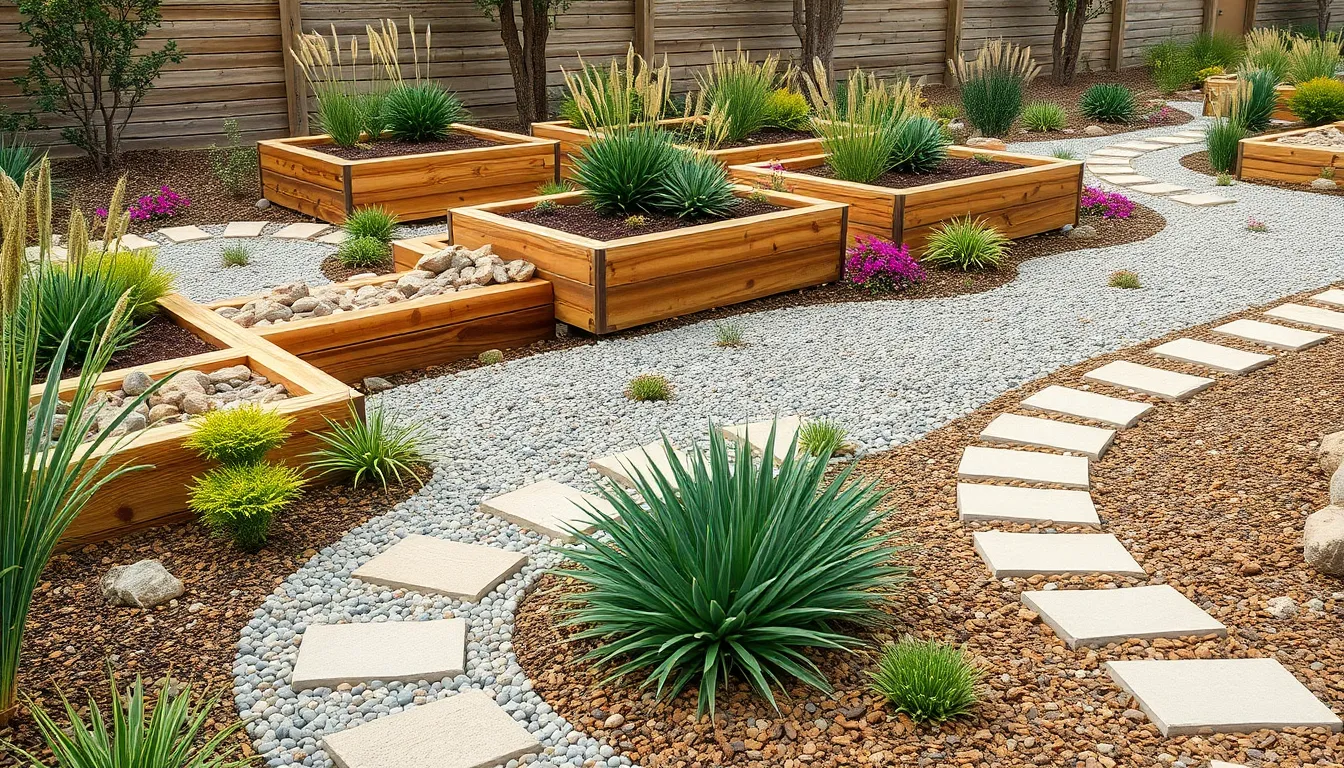
We can significantly reduce garden maintenance while creating stunning visual appeal by integrating non-living features into our dry garden design. Strategic hardscaping transforms water-hungry landscapes into sustainable spaces that thrive with minimal intervention.
Build Raised Planting Beds with Proper Drainage
Raised beds elevate our plants above native soil and provide the superior drainage that’s critical for dry gardening success. Construction involves creating well-draining soil mixes and lining the base with gravel to prevent waterlogging that can damage drought-resistant plants.
Elevated planting encourages deeper root growth and reduces the risk of root rot, making our selected plants more tolerant to dry conditions. Timing matters when we establish these beds—planting in fall or spring allows roots to develop strong systems before summer heat stress arrives.
We’ll achieve better plant survival rates by building beds 12-18 inches high with a gravel foundation layer. Materials like cedar, composite lumber, or stone blocks create durable structures that complement our dry garden aesthetic while supporting optimal plant health.
Add Decorative Mulch and Gravel Surfaces
Mulching with chipped bark, gravel, or mineral materials conserves precious soil moisture while keeping plant roots cool and suppressing competitive weeds. Gravel surfaces prove especially effective in dry gardens because they prevent soil disturbance and reflect heat away from sensitive plants.
Visual interest increases when we select mulches that complement our hardscaping palette—decomposed granite, river rock, or colored stones create cohesive design elements. Both organic and mineral mulches reduce our maintenance workload by eliminating the need for frequent weeding and watering.
We recommend applying 2-3 inches of mulch around plants while leaving space near stems to prevent moisture-related issues. Decorative gravel pathways between planted areas create attractive transitions and provide practical walking surfaces that never require mowing or trimming.
Install Permeable Paving Answers
Permeable paving allows rainwater to seep into the ground rather than running off, recharging groundwater and reducing erosion in our dry garden spaces. Answers include gravel grids, porous pavers, and stepping stones spaced to accommodate groundcovers growing between gaps.
Water conservation improves dramatically when we choose permeable materials over traditional concrete or asphalt surfaces. These installations support soil health by allowing natural water infiltration while creating defined pathways and gathering areas within our industry design.
Installation involves preparing a stable base layer and selecting materials that match our garden’s aesthetic—flagstone with moss, permeable concrete pavers, or recycled brick with drought-tolerant plants filling the joints. Each option reduces stormwater runoff while adding functional beauty to our low-maintenance garden design.
Select Color-Coordinated Plant Combinations
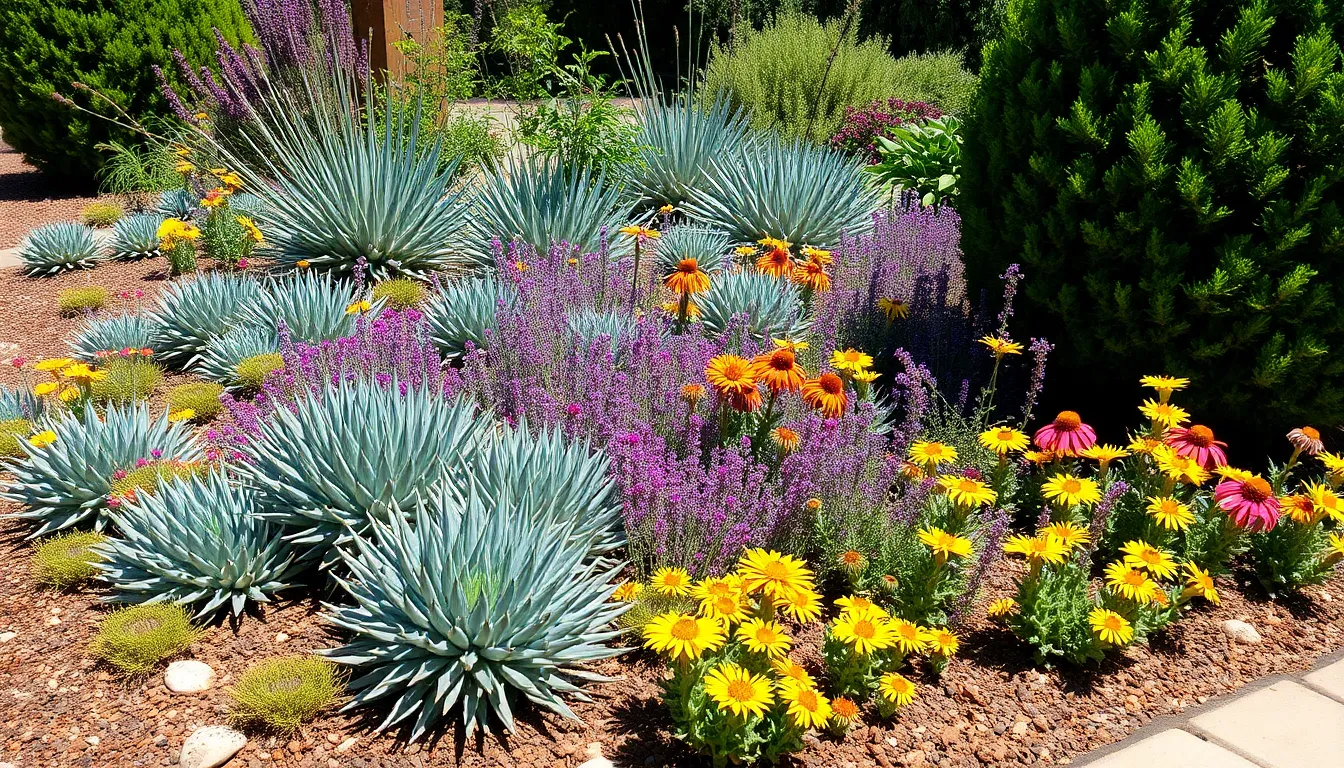
Creating visual harmony through strategic plant selection transforms our dry garden into a cohesive and stunning industry. We’ll focus on combining plants with complementary colors and textures to achieve maximum aesthetic impact while maintaining drought resistance.
Choose Silver and Blue-Gray Foliage Plants
Silver and blue-gray foliage plants serve as the perfect foundation for our drought tolerant design. Sedum varieties offer succulent leaves in silvery tones that reflect sunlight and reduce heat stress throughout our garden. Yucca plants provide architectural blue-gray spikes that create striking vertical elements while requiring minimal water.
These reflective foliage colors help cool our garden environment by bouncing harsh sunlight away from surrounding plants. We can pair these silvery specimens with darker green companions to create natural contrast and depth. Popular options include Dusty Miller, Lamb’s Ear, and Blue Fescue grass for their consistent coloring and low maintenance requirements.
The cooling effect of silver foliage makes these plants ideal for hot, sunny locations where other species might struggle. We recommend grouping three to five different silver-toned plants together to create impactful visual clusters that anchor our garden design.
Add Pops of Color with Drought-Resistant Flowers
Drought resistant flowers bring vibrant energy to our xerophytic industry without compromising water efficiency. Lavender produces fragrant purple spikes that bloom repeatedly throughout the growing season while attracting beneficial pollinators. Coneflowers offer bold pink, purple, and white blooms that persist through summer heat and provide seeds for wildlife.
Desert Marigolds deliver bright yellow flowers that bloom almost year round in warmer climates. We can create stunning color combinations by pairing warm toned flowers like orange California Poppies with cool purple Salvia blooms. These flowering plants typically require watering only once or twice per week once established.
Timing our flower selections ensures continuous blooms from spring through fall. Early bloomers like Desert Lupine can overlap with summer favorites such as Blanket Flower and late season Autumn Sage for extended color displays.
Create Seasonal Interest with Evergreen Varieties
Evergreen plants maintain our garden’s structure and visual appeal throughout all seasons. Creeping Juniper spreads horizontally to create living ground cover that stays green year round while requiring virtually no supplemental watering. Boxwood shrubs can be shaped into formal hedges or left natural for informal borders that provide consistent backdrop color.
We can use evergreen varieties to create permanent framework elements that support seasonal flowering plants. Pine species adapted to dry conditions offer vertical structure and interesting needle textures that contrast beautifully with broad leafed companions. Rosemary serves double duty as an evergreen herb that produces small blue flowers while maintaining its aromatic foliage.
These permanent plantings reduce our garden’s maintenance needs by eliminating the need to replant seasonal areas each year. Strategic placement of evergreens creates windbreaks that protect more delicate flowering species during harsh weather conditions.
Maximize Soil Health for Dry Conditions
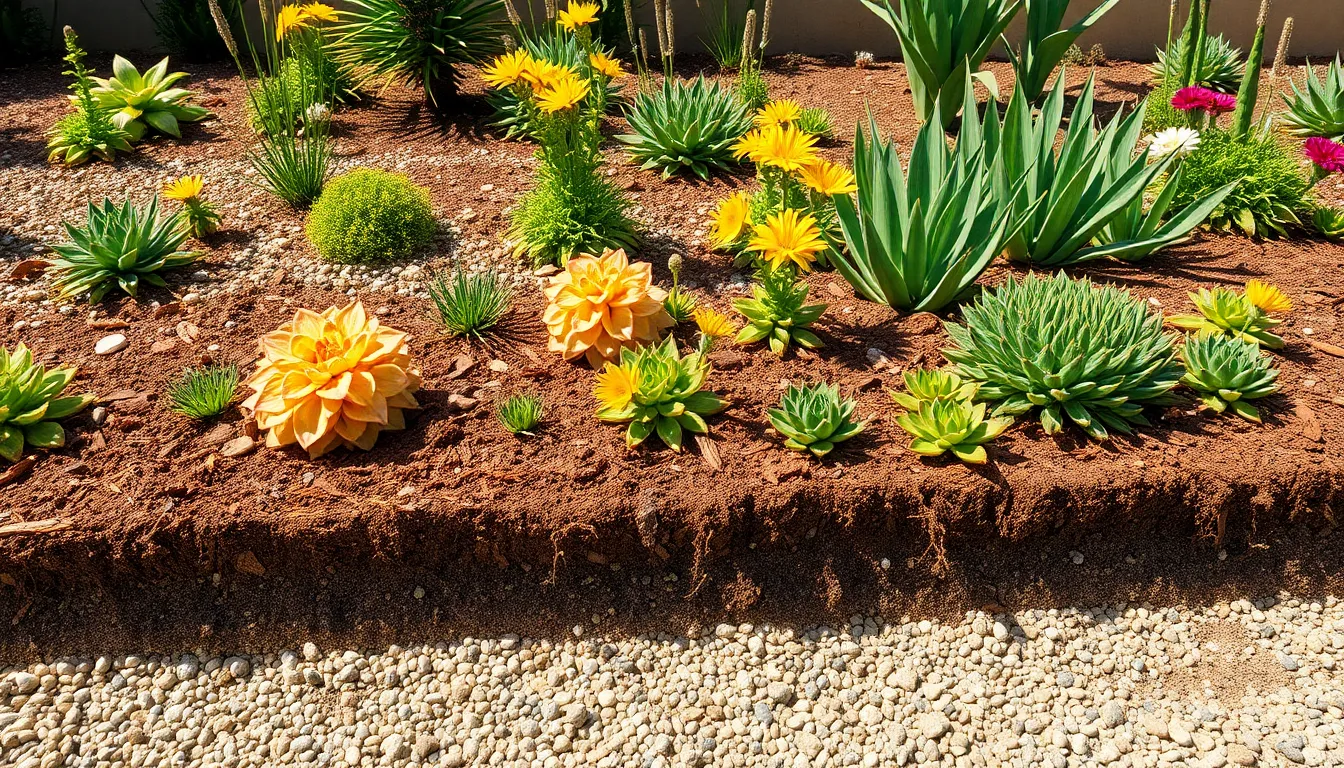
Building healthy soil forms the foundation for any successful dry garden, ensuring your drought-resistant plants can establish deep root systems and access stored moisture efficiently. We’ll focus on three essential strategies that transform ordinary soil into a thriving network for water-wise gardening.
Improve Drainage with Soil Amendments
Adding drainage-improving materials prevents waterlogging and root rot in your dry garden plantings. We recommend incorporating perlite, vermiculite, or coarse sand into your existing soil to create better water flow pathways. Mix gravel directly into planting areas to help rapid drainage while simultaneously suppressing weed growth around your drought-tolerant plants.
Sand amendments work particularly well for clay-heavy soils that tend to retain too much moisture during occasional rainfall. Perlite offers excellent aeration properties and helps create air pockets that roots need for healthy development. Vermiculite provides both drainage and nutrient retention, making it ideal for areas where you want to balance water flow with soil fertility.
Apply Organic Mulch to Retain Moisture
Organic mulching materials create a protective barrier that reduces water evaporation from your soil surface. We suggest using bark chips or straw around your drought-resistant plantings to maintain consistent soil moisture levels without frequent watering. Gravel mulch offers dual benefits by retaining soil warmth during cooler periods and preventing weed establishment around your dry garden plants.
Bark mulch breaks down slowly, adding organic matter to your soil while providing long-lasting moisture conservation. Straw mulch works exceptionally well in vegetable areas of your dry garden, decomposing to enrich the soil structure. Gravel alternatives create attractive visual contrast while requiring zero replacement, making them perfect for low-maintenance dry garden designs.
Test and Adjust Soil pH Levels
Regular pH testing ensures your drought-tolerant plants can access essential nutrients from the soil effectively. We recommend checking soil acidity levels at least twice per year to maintain optimal growing conditions for your selected plant varieties. Adjust alkaline soils by adding sulfur-based amendments, while lime applications help neutralize overly acidic conditions in your dry garden beds.
Most drought-resistant plants prefer slightly alkaline to neutral soil conditions, typically ranging from 6.5 to 7.5 pH. Native plants often adapt to your region’s natural soil pH, requiring fewer adjustments than non-native species. Digital pH meters provide accurate readings that help you make precise amendments rather than guessing at your soil’s chemical balance.
Design Functional Outdoor Living Spaces
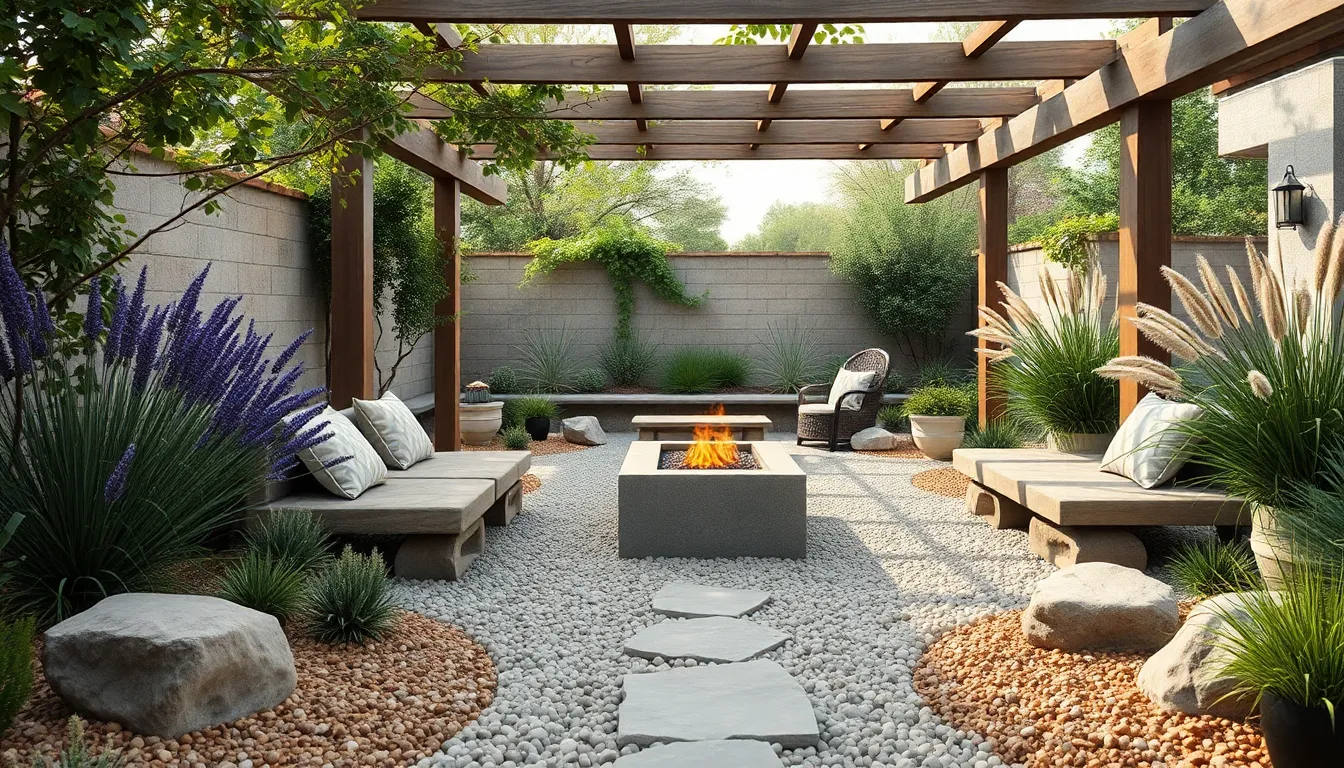
Creating outdoor living spaces within our dry gardens transforms these water-wise landscapes into inviting areas for relaxation and entertainment.
Create Seating Areas Among Dry Garden Plants
Seating areas work best when we strategically place them among drought-tolerant plants with finely textured foliage. This balanced aesthetic creates visual interest while maintaining the garden’s water-wise principles. We can incorporate natural stone benches or wooden seating that complements our Mediterranean herbs like lavender and rosemary.
Decorative hardscapes enhance our seating zones while serving practical purposes. Natural stone elements provide durable surfaces that require minimal maintenance and blend seamlessly with xerophytic plants. We should position seating to take advantage of microclimates created by larger plants and boulders, offering comfortable spots that naturally stay cooler during hot days.
Gravel surfaces around seating areas suppress weed germination while conserving soil warmth. This practical ground cover creates defined spaces between our ornamental grasses and succulents. We can use different gravel textures and colors to delineate pathways leading to our seating areas, creating visual flow throughout the garden.
Add Shade Structures for Comfort
Shade structures like pergolas and gazebos provide essential comfort in dry, sunny gardens. These installations create cooler microclimates that make outdoor spaces more enjoyable during peak sun hours. We can design these structures to complement our existing hardscaping elements and stone pathways.
Planting beneath shade structures expands our plant palette beyond full-sun varieties. Partial shade areas accommodate succulents and Mediterranean herbs that benefit from protection during the hottest parts of the day. We should select plants that thrive in these conditions while maintaining our water-wise gardening principles.
Umbrellas offer flexible shade answers that we can move as needed. These portable options work well near seating areas and fire features, allowing us to adjust coverage based on seasonal sun patterns. We can anchor them in gravel surfaces or use weighted bases that won’t damage our drought-resistant plantings.
Install Fire Features for Year-Round Enjoyment
Fire pits and fireplaces extend our outdoor living season into cooler months. These features create cozy gathering spots that enhance the ambiance of our dry gardens. We should position them safely away from our drought-tolerant plants while maintaining clear sight lines to our rock gardens and decorative stone features.
Safety considerations require proper installation and maintenance of all fire features. We need to follow local regulations and ensure adequate clearance from our ornamental grasses and other plantings. Regular cleaning and inspection help prevent accidents while preserving the beauty of our surrounding industry.
Fire features serve as focal points that complement our boulder placements and terraced areas. The warm glow highlights the textures of our stone pathways and creates dramatic shadows among our xerophytic plants. We can use fire-resistant materials like natural stone for surrounding surfaces, maintaining consistency with our overall hardscape design.
Conclusion
Creating a successful dry garden requires thoughtful planning and the right combination of elements working together. We’ve shown you how strategic plant selection paired with smart design techniques can transform any space into a thriving water-wise industry.
The key lies in understanding your local conditions and choosing plants that naturally flourish in dry environments. When we combine drought-tolerant vegetation with efficient irrigation systems and proper soil preparation we create gardens that are both sustainable and stunning.
Remember that dry gardening isn’t about sacrificing beauty for practicality – it’s about embracing a different aesthetic that celebrates resilience and natural adaptation. With these proven strategies you’ll develop an outdoor space that requires minimal maintenance while providing maximum visual impact year after year.
Frequently Asked Questions
What is water-wise gardening and why is it beneficial?
Water-wise gardening, also known as xeriscaping, is a landscaping approach that uses drought-tolerant plants and design techniques to create beautiful gardens with minimal water requirements. It’s beneficial because it reduces water consumption, lowers maintenance costs, and creates stunning outdoor spaces that thrive in challenging conditions like drought or poor soil.
Which plants are best for dry gardens?
The best plants for dry gardens include native succulents and cacti like Agave and Prickly Pear, Mediterranean herbs such as lavender and rosemary, and ornamental grasses like Fountain Grass and Blue Fescue. These plants are naturally drought-resistant, require minimal care, and often provide additional benefits like culinary value or visual texture.
How can I create visual interest in a drought-tolerant garden?
Create visual interest by incorporating rock gardens with varying stone sizes, installing decorative stone pathways using flagstones or cobblestones, and strategically placing boulders as focal points. Add ornamental grasses for texture and movement, and use drought-tolerant flowers like zinnias and marigolds to enhance color and visibility throughout the garden.
What irrigation systems work best for water-wise gardens?
Drip irrigation systems are most effective for water-wise gardens as they deliver water directly to plant roots, reducing water usage compared to traditional sprinklers. Smart timers and moisture sensors can automate irrigation based on weather data, while rainwater collection systems provide sustainable water sources and reduce reliance on municipal supplies.
How do I improve soil health for dry gardening conditions?
Improve soil health by enhancing drainage with amendments like perlite, vermiculite, and coarse sand to prevent waterlogging. Use organic mulch such as bark chips to retain moisture and reduce evaporation. Regularly test and adjust soil pH levels to ensure optimal nutrient access for drought-tolerant plants, maintaining ideal growing conditions.
Can I include functional outdoor living spaces in my dry garden?
Yes, you can create functional outdoor spaces by installing natural stone benches and gravel surfaces among drought-tolerant plants. Add shade structures like pergolas or gazebos to expand plant options and provide comfort. Fire features such as pits or fireplaces extend outdoor enjoyment into cooler months while maintaining the water-wise garden aesthetic.
How should I organize my water-wise garden layout?
Organize your garden into distinct zones based on water requirements, grouping plants with similar needs together for efficient irrigation. Create microclimates using windbreaks and mulch to protect sensitive plants. Design strategic shade areas with larger plants and hardscaping elements to provide natural protection for smaller species and optimize growing conditions.
What hardscaping elements reduce maintenance in dry gardens?
Install raised planting beds with proper drainage using materials like cedar and stone blocks. Use decorative mulch and gravel surfaces to conserve soil moisture and suppress weeds. Consider permeable paving options that allow rainwater infiltration, improving water conservation while creating defined pathways and reducing overall garden maintenance requirements.

